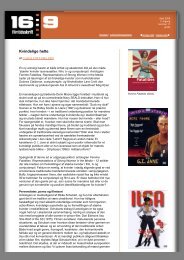Create successful ePaper yourself
Turn your PDF publications into a flip-book with our unique Google optimized e-Paper software.
his claim and stolen what is rightfully his. His friends are ready to give<br />
up, but Lars will have none of it. He literally goes berserk, and<br />
proceeds to tear the place apart with his bare hands, ripping apart<br />
walls, doors, tables and chairs, and beating up the miscreants. As a<br />
result, the villains are cowed, and Lars gets the fruits of his labors and<br />
is triumphant. It is truly a cheer-inducing scene even today, and Karl’s<br />
actions appear to represent what the people in the audience would<br />
have liked to do if they had the gumption and strength.<br />
Beyond Stereotype<br />
Some of Karl’s characterizations employ <strong>som</strong>e then common<br />
Scandinavian stereotypes. The hulking Lars, for example, is dominated<br />
by a tiny, shrewish wife, (played by frequent co-star Polly Moran). This<br />
fit the then-popular image of Scandinavian men as passive and rather<br />
emasculated types. This image predated Karl’s time, starting back in<br />
19th Century American Vaudeville. Lars’s oft-repeated cry of “Yumpin<br />
Yiminy!” was evidence of this stereotype, as is the character’s dimwittedness.<br />
At one point in the film, a crooked peddler sells him a<br />
handy device to protect himself in the wilds of Alaska from flying<br />
insects. Called “Sure Death for Mosquitoes” it is simply two small<br />
wooden blocks with which to crush their tiny bodies! Of course, the<br />
highly gullible Lars eagerly buys this product (fig. 5). However, he is<br />
sharp enough to realize the man has cheated him out of his change,<br />
and promptly goes after the hapless thief, demanding the missing<br />
coins, and giving him a boot in the derriere as he scampers off!<br />
This stereotypical dopiness exists in other of his films as well, but Karl<br />
fleshed out his characterizations so they were three-dimensional. In<br />
the baseball-themed Slide Kelly Slide (1927) his character, Swede, is<br />
no cipher. Despite his gruffness and softheadedness, he is also caring<br />
and compassionate. Together with his pal, fellow Yankees team<br />
member Kelly (played by William Haines), they take in a homeless and<br />
hungry waif (Frank “Junior” Coghlan Jr.), and “adopt” him, making him<br />
the team’s batboy. This film also shows a very sensitive, emotional side<br />
to Karl’s range as an actor. In one touching scene, Mickey rejects and<br />
insults poor Swede, who has bought him a hideously vulgar suit of<br />
clothes (another Nordic stereotype). However, Kelly chides the boy and<br />
makes him apologize to the big guy, who has broken into tears and fled<br />
the room. Their reconciliation scene, in which Swede takes the little boy<br />
into his arms, is poignant indeed and shows that Karl was a wellrounded<br />
performer fully capable of so much more than straight<br />
comedy.<br />
Karl was in fact in such demand that other studios were requesting his<br />
services. MGM loaned him out to United Artists in 1926 to make The<br />
Son of the Sheik with the legendary Rudolph Valentino. This would be<br />
the Great Lover’s last role before his own tragic death. Karl played<br />
Ramadan, friend and loyal manservant to Valentino’s Ahmed, the film’s<br />
titular hero.<br />
In the story, Ahmed falls in love with Yasmin, a dancing girl (played by<br />
Vilma Banky). However, he mistakenly comes to believe that she has<br />
betrayed him to a group of bandits who capture, torture and whip him.<br />
In a politically incorrect plot point at which modern audiences cringe,<br />
Ahmed takes his vengeance by forcing himself on her. Ramadan,<br />
however, saves the day when he discovers the truth, and races across<br />
the desert in a sandstorm to inform Ahmed. This paves the way for the<br />
young lovers to be reunited at the film’s end.<br />
”The Great Dane and The Amazing Arthur”<br />
In addition to appearing in films solo, MGM also paired Karl with short<br />
British comic George K. Arthur (fig. 6). The comedy team Dane &<br />
Arthur, also known as The Great Dane and the Amazing Arthur, were<br />
often cast as adversaries in their films: Arthur was the spoiled,<br />
<strong>som</strong>ewhat effeminate, but smarter of the duo, and Karl was the big,<br />
lumbering bully who was his rival for the same girl. Usually, it was the<br />
more sympathetic Arthur who won love at the end, leaving Karl<br />
heartbroken and chastened, but with a new respect for his old enemy.<br />
Their first film together was the Army-themed Rookies (1927) (fig. 7),<br />
which began this popular comedy formula. They continued to use this<br />
formula successfully for their next five features together, all of which<br />
earned good profits for MGM.<br />
In 1927, at the height of Karl’s fame, the first talking pictures were<br />
released. There was considerable anxiety at the studio since no one<br />
Fig. 5: George Cooper, Tully Marshall and<br />
Karl.<br />
Fig. 6: George K. Arthur.
















